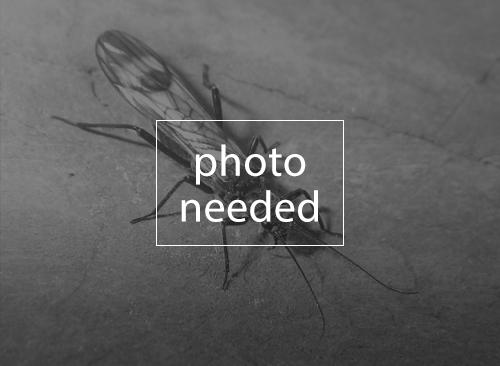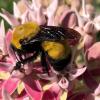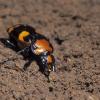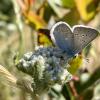
Ashmeadiella sculleni, known from three locations in eastern Oregon and northwest Nevada, is a specialist forager on Penstemon flowers.
Taxonomic Status
Ashmeadiella (Ashmeadiella) sculleni Michener, 1939
The flight season of Ashmeadiella sculleni is in June to mid-July. It appears to be a specialist forager on plant in the genus Penstemon (beardtongue, penstemon). Little is known about its nesting habits. It nests in abandoned beetle tunnels in snags and stumps (Tepedino and Griswold, 1995), as do many members of the subgenus Ashmeadiella. Krombein (1967, in Michener, 2000) reported that several Ashmeadiella species make cell partitions from gummy leaf pulp (probably leaf pulp mixed with nectar, gum, or resin) and occasionally of resin.
Ashmeadiella sculleni has been recorded from single localities in Baker and Harney counties, OR, and one in northern Humboldt County, NV. Given the distance between these three sites, it is possible that this bee is more widely distributed.
Xerces Red List Status: Vulnerable
Other Rankings:
Canada Species at Risk Act: N/A
Canada provincial status: N/A
Mexico: N/A
USA Endangered Species Act: N/A
USA state status: N/A
NatureServe: N/A
IUCN Red List: N/AAs a rare endemic species known from only three localities, the future of Ashmeadiella sculleni should be considered at risk.
Little is known of this bee, making it difficult to assess threats. However, as a specialist forager it is more vulnerable to habitat change than generalist foragers that can adapt as plant communities alter.
An important conservation need is to ensure that flowering plants of the genus Penstemon persist and that suitable beetle riddled snags or other appropriate nesting substrate remains. Little is known of the biology of this species. Studies of both the nesting and foraging habits would be valuable. Searches of its known sites and surrounding areas should be done to confirm the distribution.
Krombein, K.V. 1967. Trap-Nesting Wasps and Bees: Life Histories, Nests, and Associates. 570 pp. Washington, DC: Smithsonian Press.
Michener, C.D. 2000. The Bees of the World. Baltimore, MD: Johns Hopkins University Press.
Tepedino, V.J., and T.L. Griswold. 1995. The bees of the Columbia Basin. Final report, USDA Forest Service, Portland, OR. 212 pp (Technical Report)
Citation
Shepherd, M. D. 2005. Species Profile: Ashmeadiella sculleni. In Shepherd, M. D., D. M. Vaughan, and S. H. Black (Eds). Red List of Pollinator Insects of North America. CD-ROM Version 1 (May 2005). Portland, OR: The Xerces Society for Invertebrate Conservation.
Profile prepared by Matthew Shepherd, The Xerces Society for Invertebrate Conservation





